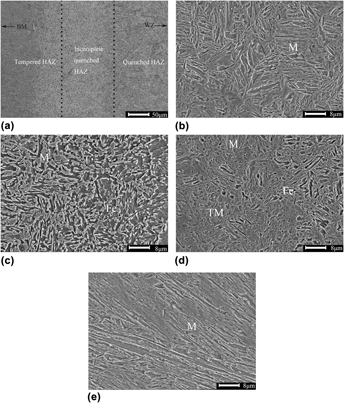Crossref Citations
This article has been cited by the following publications. This list is generated based on data provided by
Crossref.
Zhang, Yulong
Lu, Fenggui
Wang, Hui-Ping
Wang, Xiaojie
Cui, Haichao
and
Tang, Xinhua
2015.
Reduced hot cracking susceptibility by controlling the fusion ratio in laser welding of dissimilar Al alloys joints.
Journal of Materials Research,
Vol. 30,
Issue. 7,
p.
993.
Zhang, Yulong
Lu, Fenggui
Cui, Haichao
Cai, Yan
Guo, Songtao
and
Tang, Xinhua
2016.
Investigation on the effects of parameters on hot cracking and tensile shear strength of overlap joint in laser welding dissimilar Al alloys.
The International Journal of Advanced Manufacturing Technology,
Vol. 86,
Issue. 9-12,
p.
2895.
Javidan, Fatemeh
Heidarpour, Amin
Zhao, Xiao-Ling
Hutchinson, Christopher R.
and
Minkkinen, Jussi
2016.
Effect of weld on the mechanical properties of high strength and ultra-high strength steel tubes in fabricated hybrid sections.
Engineering Structures,
Vol. 118,
Issue. ,
p.
16.
Kügler, H.
Mittelstädt, C.
and
Vollertsen, F.
2016.
Influence of Joint Configuration on the Strength of Laser Welded Presshardened Steel.
Physics Procedia,
Vol. 83,
Issue. ,
p.
373.
Kügler, Helge
Möller, Felix
Goecke, Sven-Frithjof
and
Vollertsen, Frank
2016.
Fatigue strength of hybrid welded 22MnB5 overlap joints.
Materials Testing,
Vol. 58,
Issue. 6,
p.
569.
Liu, Chengjie
Zheng, Xiankun
He, Hongyu
Wang, Wurong
and
Wei, Xicheng
2016.
Effect of work hardening on mechanical behavior of resistance spot welding joint during tension shear test.
Materials & Design,
Vol. 100,
Issue. ,
p.
188.
Xie, Chaojie
Yang, Shanglei
Liu, Haobo
Zhang, Qi
Cao, Yaming
and
Wang, Yuan
2017.
Microstructure and Fatigue Properties of Laser Welded DP590 Dual-Phase Steel Joints.
Journal of Materials Engineering and Performance,
Vol. 26,
Issue. 8,
p.
3794.
Cen, Yaodong
Chen, Furong
and
Li, Congzeng
2017.
Processing optimization and comprehensive performance on resistance plug welding of dissimilar steel joints.
Journal of Materials Research,
Vol. 32,
Issue. 12,
p.
2297.
Di, Hong Shuang
Sun, Qian
Nie, Xiao Kang
Wang, Xiao Nan
and
Chen, Xia Ming
2017.
Mirostructure and properties of laser welded joints of dual phase and press-hardened steels.
Procedia Engineering,
Vol. 207,
Issue. ,
p.
1665.
Sowards, J.W.
Pfeif, E.A.
Connolly, M.J.
McColskey, J.D.
Miller, S.L.
Simonds, B.J.
and
Fekete, J.R.
2017.
Low-cycle fatigue behavior of fiber-laser welded, corrosion-resistant, high-strength low alloy sheet steel.
Materials & Design,
Vol. 121,
Issue. ,
p.
393.
Jia, Qiang
Liu, Lei
Guo, Wei
Peng, Yun
Zou, Guisheng
Tian, Zhiling
and
Zhou, Y.
2018.
Microstructure and Tensile-Shear Properties of Resistance Spot-Welded Medium Mn Steel.
Metals,
Vol. 8,
Issue. 1,
p.
48.
Wan, Zhandong
Guo, Wei
Jia, Qiang
Xu, Lang
and
Peng, Peng
2018.
Hardness Evolution and High Temperature Mechanical Properties of Laser Welded DP980 Steel Joints.
High Temperature Materials and Processes,
Vol. 37,
Issue. 6,
p.
587.
Yang, Lijun
Gao, Shuling
Huang, Yiming
Sun, Mingsheng
and
Li, Yuntao
2019.
Effect of microstructure on tensile and fatigue properties of laser-welded DP780 and DP980 high-strength steel joints.
Materials Science and Engineering: A,
Vol. 754,
Issue. ,
p.
535.
Afkhami, Shahriar
Björk, Timo
and
Larkiola, Jari
2019.
Weldability of cold-formed high strength and ultra-high strength steels.
Journal of Constructional Steel Research,
Vol. 158,
Issue. ,
p.
86.
Yaakob, K.I.
Ishak, M.
Quazi, M.M.
and
Salleh, M.N.M.
2019.
Optimizing the pulse wave mode low power fibre laser welding parameters of 22Mnb5 boron steel using response surface methodology.
Measurement,
Vol. 135,
Issue. ,
p.
452.
Wang, Wurong
Zhu, Qiang
Liu, Chengjie
and
Wei, Xicheng
2019.
An investigation on the resultant-based failure criterion for resistance spot welding joint in crush test.
International Journal of Crashworthiness,
Vol. 24,
Issue. 2,
p.
152.
Kim, Hyung-gyu
Lee, Hye-Jin
Park, Sung Hyuk
Park, Sung-Jun
and
Yoon, Jonghun
2020.
Effect of laser patterning on the material behaviour of 22MnB5 steel with induced local strengthening.
The International Journal of Advanced Manufacturing Technology,
Vol. 107,
Issue. 11-12,
p.
4983.
Cao, Xiaobing
Zhou, Xiongfeng
Wang, Haoran
Luo, Zhi
and
Duan, Ji'an
2020.
Microstructures and mechanical properties of laser offset welded 5052 aluminum to press-hardened steel.
Journal of Materials Research and Technology,
Vol. 9,
Issue. 3,
p.
5378.
Li, Muyu
Yao, Dan
Guan, Yingping
Duan, Yongchuan
and
Yang, Liu
2020.
Effect of Welding Speed and Post Quenching on the Microstructure and Mechanical Properties of Laser-Welded B1500HS Joints.
Materials,
Vol. 13,
Issue. 20,
p.
4645.
Wang, Z.W.
Zhang, H.
An, X.H.
Wu, L.H.
Xue, P.
Zhang, Q.C.
Ni, D.R.
Xiao, B.L.
and
Ma, Z.Y.
2020.
Achieving equal strength joint to parent metal in a friction stir welded ultra-high strength quenching and partitioning steel.
Materials Science and Engineering: A,
Vol. 793,
Issue. ,
p.
139979.
